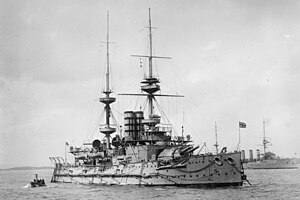
Back Mars (Schiff, 1897) German اچاماس مارس (۱۸۹۶) FA HMS Mars (1896) Finnish אה"מ מארס (1896) HE HMS Mars (1896) Portuguese
 HMS Mars at anchor
| |
| History | |
|---|---|
| Namesake | Mars, the Roman god of war |
| Builder | Laird Brothers, Birkenhead |
| Laid down | 2 June 1894 |
| Launched | 30 March 1896 |
| Completed | June 1897 |
| Commissioned | 8 June 1897 |
| Decommissioned | 7 July 1920 |
| Fate | Sold for scrapping 9 May 1921 |
| General characteristics | |
| Class and type | Majestic-class pre-dreadnought battleship |
| Displacement | 16,060 long tons (16,320 t) |
| Length | 421 ft (128 m) |
| Beam | 75 ft (23 m) |
| Draught | 27 ft (8.2 m) |
| Installed power |
|
| Propulsion | |
| Speed | 16 kn (30 km/h; 18 mph) |
| Complement | 672 |
| Armament | |
| Armour |
|
HMS Mars was a Royal Navy pre-dreadnought battleship of the Majestic class, the seventh member of a class of nine ships. The ship was laid down in the Laird Brothers shipyard in June 1894, she was launched in March 1896, and she was commissioned into the fleet in June 1897. She was armed with a main battery of four 12-inch (305 mm) guns and a secondary battery of twelve 6-inch (152 mm) guns. The ship had a top speed of 16 knots (30 km/h; 18 mph).
Mars served in the Channel Fleet after her commissioning and was present at the Coronation Fleet Review for Edward VII in 1902. She was reduced temporarily to the Reserve in March 1906 before returning to service with the Channel Fleet in October. The following March she was reassigned to the Home Fleet. As tensions in Europe rose dramatically in late July 1914, Mars was mobilized with her sister ships into the 9th Battle Squadron, based as a guard ship in the Humber. In December, she was transferred to the Dover Patrol, though in February 1915, she was decommissioned in Belfast and disarmed. Mars served as a troop ship during the Dardanelles Campaign before being converted into a depot ship. She remained in service until July 1920; the old ship was sold for scrap in May 1921 and broken up in November.